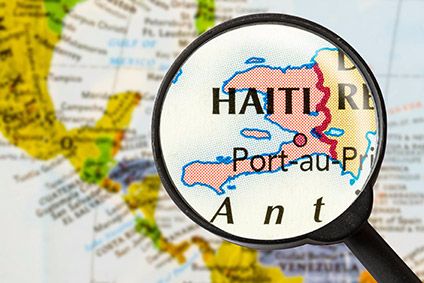
Garment manufacturing industry insiders in Haiti are optimistic that the sector can continue expanding in size, as long as the Caribbean country’s government delivers economic and social stability.
This is not a given in Haiti, which has suffered from serious political instability since the dictatorial regime of former President Jean-Claude Duvalier (‘Baby Doc’) was overthrown in 1986.
But clothing sector leaders stress that working conditions in the country’s clothing sector have been improving and predict its workforce could grow six-fold in less than a decade, if the government delivers general economic growth and effective services.
The Haiti manufacturers association – L’Association des Industries d’Haïti (ADIH) – told just-style that the clothing sector is doing its part to attract workers, improving wages and working conditions since the introduction in the US of the HOPE/HELP Acts. These are the Haitian Hemispheric Opportunity through Partnership Encouragement (HOPE), of 2006, and later the Haiti Economic Lift Programme (HELP) of 2010.
The HOPE/HELP Acts are preferential trade agreements designed specifically to boost Haiti’s manufacturing sectors, especially the apparel industry.
A recent report from the US the International Trade Commission showed the value of US imports of apparel from Haiti increased 2.1% to $866.7m in 2017, with the value of imports entering under the HOPE/HELP Acts increasing 7.9% to $577m. Garments of manmade fibres accounted for a growing share of US apparel imports from Haiti, in contrast to the declining share accounted for by cotton apparel.

US Tariffs are shifting - will you react or anticipate?
Don’t let policy changes catch you off guard. Stay proactive with real-time data and expert analysis.
By GlobalDataThe acts also link market access to Haiti upholding labour standards and rights, insisting that garment manufacturers improve working conditions and practices to benefit from their provisions.
Haitian garment factory owners say the sector can employ as many as 300,000 workers by 2026, with new factory builds now underway
ADIH president Georges Sassine says Haiti’s clothing sector has responded positively: in 2006, just 9,000 people were employed in the Haiti garment industry, a number that has increased to 52,000 today. He told just-style that Haitian garment factory owners say the sector can employ as many as 300,000 workers by 2026, with new factory builds now underway.
These include units in the Lafito Industrial Free Zone owned by the Gilbert Bigio (GB) Group, (owned by Haitian businessman Gilbert Bigio), that is being developed and is located at Port Lafito, a Panamax port north of the capital Port au Prince.
The free zone will house at least 20 factories, says its developer, with activewear manufacturer Reliable Source Industrial (RSI) of Taiwan as its anchor tenant. When completed, RSI expects to employ over 5,000 workers and will have the first LEED Silver certified manufacturing facilities in Haiti.
Another is the Digneron Industrial Park owned by Haiti’s Palm Apparel Group being developed in Carrefour, south-west of Port au Prince.
“Right now, buildings are being built but not yet occupied. By this time next year another 10,000 to 15,000 jobs should be added,” Sassine predicts.
He argues that the HOPE/HELP laws had boosted working conditions at the country’s garment factories. The HOPE Act requires Haiti to establish a labour ombudsman office and to ask the International Labour Organization (ILO) to inspect and assess factories to ensure labour standards are being followed insisting on improvements if Haitian manufacturers want to benefit from the trade agreement.
“The work environment has drastically changed,” says Sassine. “Factories are being monitored as part of the ILO Better Work Programme and reports are done twice a year on conditions.”
Wage concerns
Wages, however, remain a major concern. In 2017, there were a series of protests from mid-May through to the end of July, involving factory closures and 18,000 workers either striking of demonstrating calling for an increase in the minimum wage, which now stands at around HTG371 (US$5.50) a day.
However, Sassine argues that broader government policies and the quality of life they deliver to Haitians – not financial compensation – are the real problem restricting sustainable general economic growth that would help the clothing sector to expand quickly.
“Compare Haiti to Nicaragua – we function the same with factories and conditions, the only difference is outside the factory. What kind of food is available for their workers, the cost of transportation, educating their children? That’s what Haiti lacks,” says Sassine. He notes government efforts this year (now abandoned) to hike fuel prices, which would have increased transport costs and food bills, depressing the overall standard of living, made it harder for workers to leave home and take on work at clothing factories.
Factory owner Andy Apaid, head of Alpha Industries, a major clothing manufacturing group in Haiti, agrees. He says some of his workers earn US$7 to US$8 a day – well above the admittedly very low gross national income per capita for Haitians (US$790 in 2016, according to the World Bank). He also notes “everything is ripe” for more workers to come into the industry – except political stability.
ADIH points to the resignation of Prime Minister Jack Guy Lafontant in June over the attempt to increase fuel prices in July this year, which sparked violent protests and looting. The association says such instability would deter investment, and could make workers more reluctant to take on manufacturing jobs (the country’s unemployment rate is around 14% according to the Trading Economics data service).
“If we can manage the political environment, which is a big challenge, then we believe over an eight-year period Haiti can have 300,000 jobs in place in this sector,” Apaid told just-style, mirroring Sassine’s comments.
See also:
- AAFA formalises relationship with Haiti apparel sector
- Unions call on apparel brands to support workers in Haiti
- Timberland to buy up to one-third of cotton from Haiti
- Higher annual limit on Haiti duty-free apparel
- Sae-A Trading leads another medical mission in Haiti



